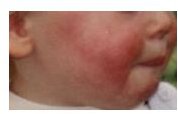Fifth Disease of Children: A Discussion of the Parvovirus B19
Introduction
Fifth Disease of children, also known as Erythema infectiosum, is a common infection with flulike symptoms and redness of the skin (erythema). The origin of the name Fifth Disease dates back to the late nineteenth century, as this was the fifth in a series of six childhood rashes that occurred on the skin. The other diseases were measles, scarlet fever, rubella (German measles) and another non-specific disease that was just named Fourth Disease.
This childhood disease is caused by the human parvovirus B19 and is transmitted through respiratory secretions or direct contact with another person. This parvovirus was determined to be the cause of Fifth’s Disease in 1975. The incubation period is between 4 to 14 days but can be as long as 20 days. Unfortunately, a child can be contagious before the onset of symptoms, which makes it a spreadable disorder, especially in a school setting. Fifth disease is prevalent among children during winter and spring and within the elementary and middle school age, although it is not unheard that a younger child can get this infection.
Signs and Symptoms
Here are the signs and symptoms your child may have with Fifth Disease:
- Fever
- Muscle aches
- Joint pains – more common in adults than children; however, could become a complication in Fifth disease of children
- Headache
- Red rash on face that looks like a “slapped cheek” at the beginning of symptoms
- Red rash turns into a lace-looking rash that appears on the chest, arms, thighs and buttocks
- The rash may leave and recur when exposed to sunlight, heat, stress or when exercising
- Some children may have the infection without symptoms
- Disease can become severe in children with compromised immune systems
- Other possible symptoms are sore throats, swollen glands, red eyes and diarrhea
Diagnostic Procedures
Human parvovirus B19 can be detected in throat cultures along with an examination of respiratory secretions and blood serum. The B19 specific antibodies can be detected in a blood test, and if the IgM is elevated, this means the child has/or has had a recent infection.
Treatment and Prevention of Spreading Fifth Disease
There is no specific treatment, although fever should be controlled. Keep children away from school and other children until most symptoms have subsided. After the rash appears, the child is no longer contagious. Check with school administrators before sending your child back to class.
Good hygiene is the means of prevention. Use good hand-washing techniques with soap and water throughout the day, especially before and after eating and handling food, wiping the nose and mouth, and toileting. Make sure to dispose of contaminated tissues and using paper plates, cups and eating utensils may be wise during the contagious period.
It is also important to notify the school if your child is diagnosed with Fifth Disease, so administrators can alert parents in the event their child was exposed during the contagious period.
Any woman in her pregnancy (especially in the early months) who has been exposed needs to contact her doctor immediately. The fetus may develop severe anemia and the mother could miscarry. Most women are immune to this disorder since they may have had it when they were young. If infected now, five percent or less of pregnant women have serious problems.
The Bottom Line…
Fifth Disease of children is a common childhood disorder and usually runs its course without complications. There is no treatment or vaccine – just to keep the child comfortable with his symptoms. To prevent any unusual concern, the human parvovirus B19 is not related to the parvovirus that is found in dogs and other animals.
References
CDC – Parvovirus B-19 (Fifth Disease) https://www.cdc.gov/ncidod/dvrd/revb/respiratory/parvo_b19.htm
CDC – Fifth Disease and Pregnancy https://www.cdc.gov/ncidod/dvrd/revb/respiratory/B19&preg.htm
Parvovirus and Fifth Disease - https://pathmicro.med.sc.edu/mhunt/parvo.htm
Photo credit by jfdwolff - https://commons.wikimedia.org/wiki/File:Slapped_cheek.png
